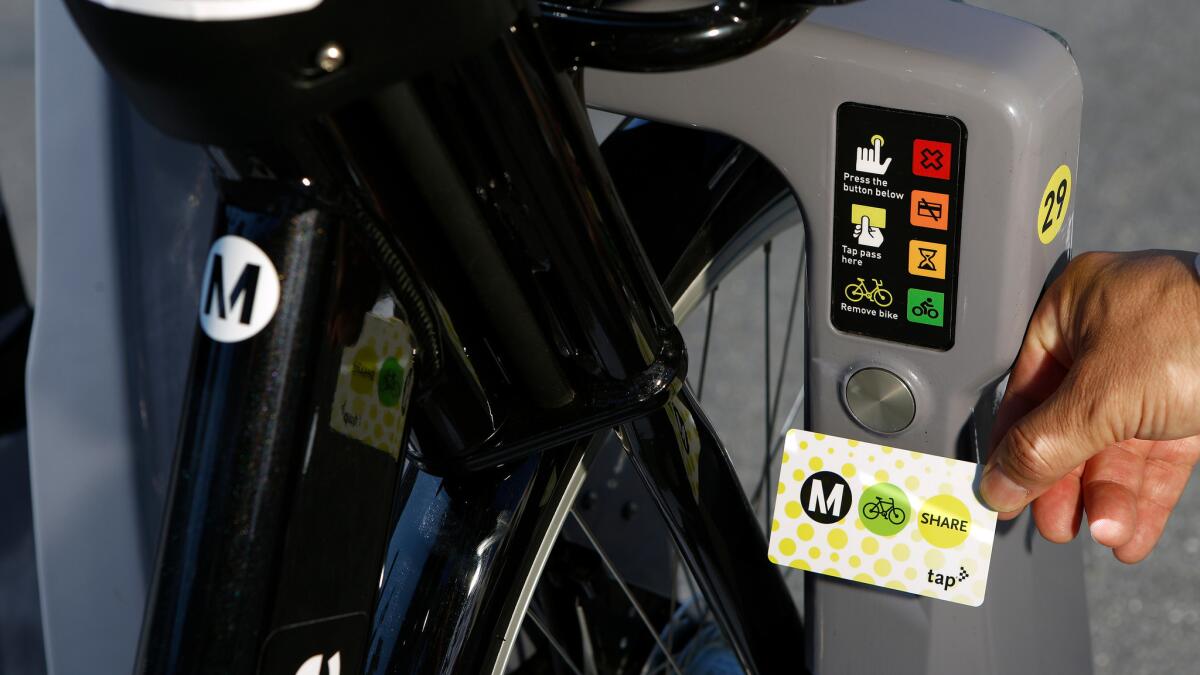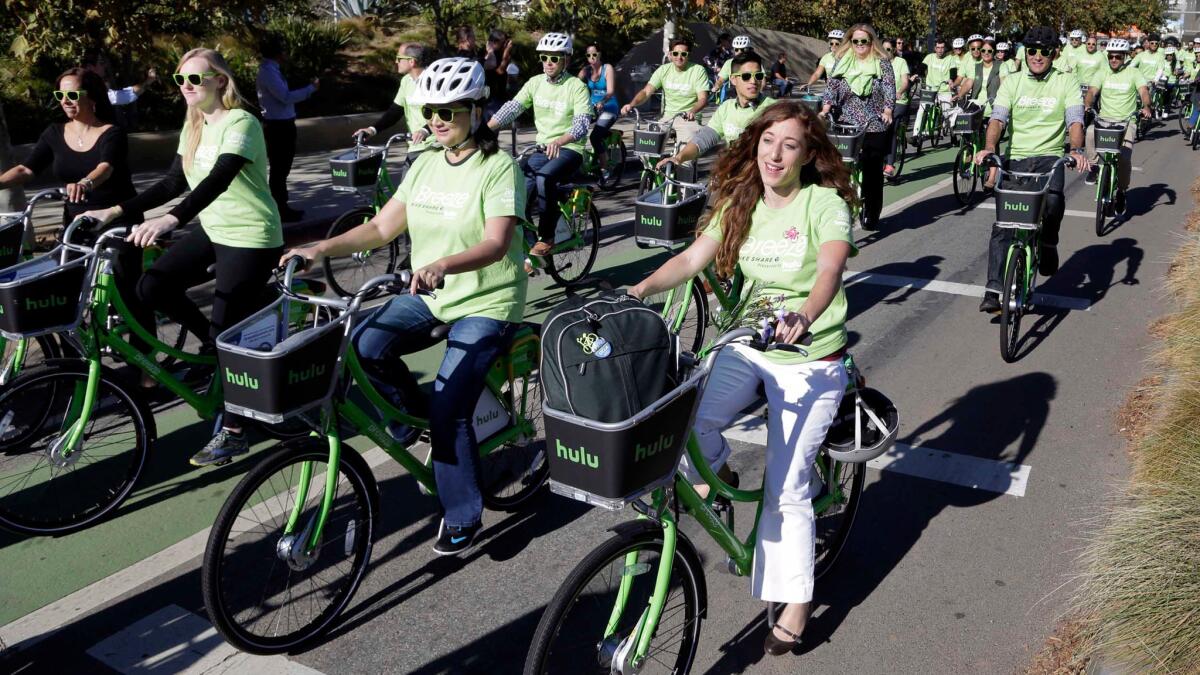Q&A: How does downtown L.A.’s bike-share system work?
The first bike-share system in Los Angeles will launch Thursday, marking the end of a years-long push to join the ranks of dozens of other cities across the world that have similar programs available for commuters and tourists.
Transportation officials have hailed the arrival of bicycle sharing as a sign that the worm has turned in car-choked Los Angeles.
“The car capital of the world is being redefined to embrace new modes of transportation,” Metro spokesman Dave Sotero said.
If you want to give the system a spin, here’s what you need to know.
What is bike-share?
Bike-share is a short-term rental program that allows users to pick up a bicycle at one station and return it to any other station in the system. It is designed for short, point-to-point trips. It also aims to bridge the so-called “first mile, last mile” gaps between transit stations and destinations.
Los Angeles is relatively late to the bike-sharing game. Similar programs are already in place in most major U.S. cities and in 25 countries in Europe.
Where are the stations?
The stations are available only in downtown Los Angeles. Many are near key destinations, including Union Station, Grand Central Market, Staples Center and the 7th Street/Metro Center station.
There will eventually be 65 bike-share stations, but some won’t be open Thursday because of installation delays caused by construction downtown, Metro said.
So, can I ride a bike Thursday?
If you’ve already purchased a pass, you can ride as much as you’d like. People who don’t want to buy a pass can start riding Aug. 1.

How do I pick up a bike?
Use Metro’s online bike map or app (available on iOS and Android) to see which station is closest.
If you’ve purchased a pass, you can walk up to the docking area, touch the silver button next to a bike, scan your Metro TAP card, and pull out the bike. The fare will automatically be deducted.
Those who don’t want to commit to a pass can pay per ride with a credit card at the attached rental kiosk.
How much does it cost?
Riders without a pass will pay $3.50 for the first half-hour and $3.50 for each half-hour after that.
Those who plan to use the system more regularly can buy a pass on Metro’s website. The two pass options are:
- A $40 annual fee, which reduces the cost of each half-hour riding period to $1.75
- A $20-per-month fee, which includes unlimited free trips shorter than 30 minutes
That sounds kind of expensive.
At $3.50, a half-hour ride will cost twice as much as a one-way ticket on Metro. But for pass holders, the $1.75 per-trip price “matches the transit fare, and our transit fares are low,” Sotero said.
Metro’s passes are more expensive than in some U.S. cities, including New York, where a monthly pass costs $15 and includes unlimited rides of 45 minutes. A pass for the Washington, D.C., system costs about $8 per month and includes unlimited 30-minute rides.
Removing the requirement to pay a hefty membership fee upfront makes it easier for low-income users to access the system, Deputy Executive Officer Laura Cornejo said.
Are there discounts available?
Until Oct. 1, the normal $3.50 price for a half-hour ride will be discounted to $1.75.
If I qualify for a discount on Metro fares, do I get a discount on bike-share?
Metro will waive the fee for the $40 annual pass for low-income riders whose households qualify for the rider relief discount program, Cornejo said.
The agency is also working to upgrade its digital fare payment system to allow discounts for students, seniors and the disabled.
Can I transfer to Metro after I use bike-share?
Yes, but you will have to pay again to enter the Metro system. Metro had considered allowing free transfers between buses, trains and bikes — essentially, integrating bike-share into L.A. County’s public transit network — but that feature won’t be available for at least a year.
So, now that the Expo Line is open to Santa Monica, can I pick up a bike in downtown and take it to the beach?
Metro doesn’t recommend it. Santa Monica has a bike-share system that opened last year, but it isn’t compatible with L.A.’s. That means you’ll keep racking up charges until you return the bike downtown.

Why aren’t the systems compatible?
Long Beach, Beverly Hills, West Hollywood and UCLA have all selected the same vendor as Santa Monica, which means those systems will be compatible with each other, but not with Metro’s.
Metro officials selected a different vendor, and have maintained that the dual systems won’t be a problem. Others have fretted that it could confuse people who are unfamiliar with the systems — especially new riders and tourists.
Can I take the bike on a bus?
The bikes weigh 40 pounds and aren’t designed for that. Officials recommend dropping off the bike before boarding.
How do I return it?
Wheel the bike into any available docking space. Wait for the light to flash green, and listen for three beeps.
What if all the slots are full?
There are about twice as many slots as bikes, so you mostly won’t have trouble finding a space. If you do, you can extend your trip by 15 minutes for free and move to the next-closest station.
What if the bike gets stolen while I’m using it?
File a police report and call Metro’s bike-share customer service line: (844) 857-BIKE.
I don’t live or work downtown. When will bike-share come to my neighborhood?
Metro plans to expand the system to Pasadena next year, and then to possible future sites in Hollywood, Venice Beach and East Los Angeles.
ALSO
L.A. area congressman target of new anti-Trump ad campaign
He took part in the student walkouts a decade ago. Now he teaches young people to take a stand
How to remake the L.A. freeway for a new era? A daring proposal from architect Michael Maltzan
For more transportation news, follow @laura_nelson on Twitter.
More to Read
Sign up for Essential California
The most important California stories and recommendations in your inbox every morning.
You may occasionally receive promotional content from the Los Angeles Times.











